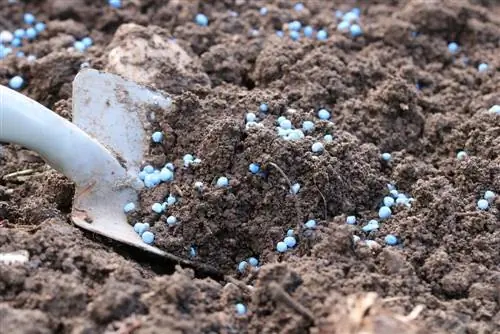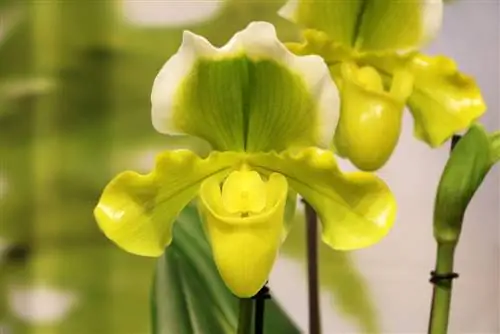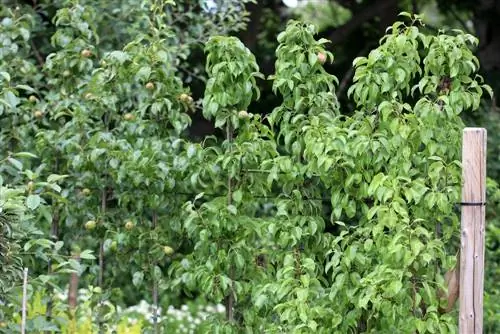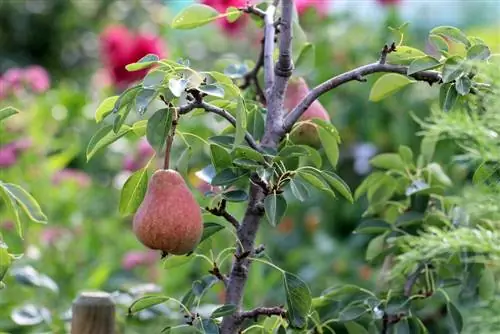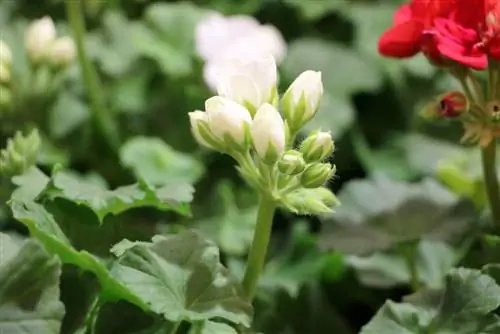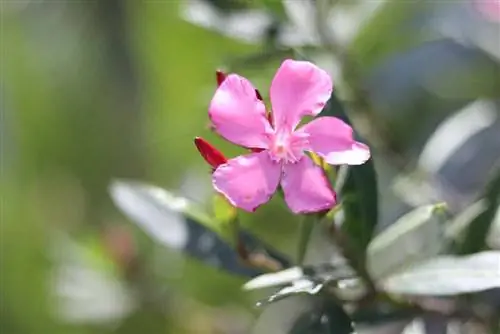- Author admin [email protected].
- Public 2023-12-17 03:39.
- Last modified 2025-01-24 12:45.
If the yield of fruit trees is low, pruning can often help. In many cases, however, the problem lies elsewhere. In order for the tree to grow he althy and strong, the soil must provide a nutrient-rich basis. Nitrogen, potassium, phosphorus and trace elements are necessary so that the fruit tree can develop shoots and a variety of flowers and fruits. In this case, the application of fertilizers can be a good support for the tree.
Nutrients
In order to grow and thrive, a fruit tree needs light and water as well as various nutrients on a regular basis. As it grows, the tree removes the existing nutrients from the soil, so that these have to be reintroduced into the garden soil. The fallen leaves form a good basis for this. Therefore it should not be thrown away but left under the trees. Well-cared for, mature fruit trees are relatively undemanding. For example, an apple tree needs the following amounts of nutrients per year:
- Nitrogen: 450 to 600 g
- Phosphorus: 100 to 200 g
- Potassium: 500 to 600 g
- Magnesium: 50 to 100 g
Since larger amounts of these substances are present in humus-rich soils, of course not all of the required amounts need to be added via fertilizer. The following applies: the larger the tree and the barren the soil, the more additional fertilization needs to be done.
Main nutrients
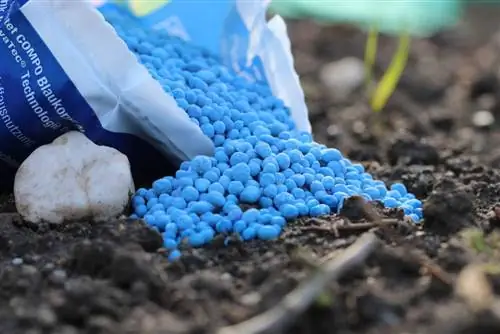
Like every living thing, fruit trees also need food. Plants feed primarily on a few basic elements.
Nitrogen (N)
Fruit trees need nitrogen primarily for growth and the formation of leaf mass. An excess of nitrogen is reflected in particularly dark green foliage and long, weak shoots. The trees are more susceptible to diseases and pests and also bear fruit with poor storage quality. A deficiency manifests itself in weak growth, small leaves and poor rooting. The fruits are also smaller.
Phosphorus (P)
Phosphorus is particularly important for the formation of flowers, fruits and chlorophyll as well as the growth of radicles. Both an excess and a deficiency of phosphorus are reflected in impaired growth. Undersupply is often accompanied by leaf tip drought.
Potassium (K)
Potassium is necessary for the tree because it regulates the water balance, strengthens the cell tissue and increases frost hardiness. Potassium also promotes the aroma of the fruit and its shelf life. A potassium deficiency is easy to recognize when fruit trees appear to wilt despite frequent watering. The leaves curl upwards and the leaf edges are dry and brown.
Other nutrients
Calcium (Ca)
Calcium deacidifies the garden soil by raising the pH value. It has a positive effect on the friability and aeration of the soil and strengthens the plant tissue. An excess of calcium traps iron and other trace elements in the soil, leading to deficiency symptoms such as leaf chlorosis.
Magnesium (Mg)
Magnesium not only regulates the tree's entire water balance, but is also the most important building block for the formation of leaf green. Fruit trees only need magnesium in small amounts. However, if it is missing, fruits remain small and the leaves become spotty.
Trace elements
In addition to small amounts of sulfur, the trees also need trace elements for he althy and strong growth. These include:
- Zinc
- Iron
- Manganese
- Copper
- Chlorine
- Boron
- Molybdenum
NPK ratio
The NPK ratio on commercial fertilizers indicates the proportions in which the main nutrients are contained in the fertilizer. Fertilizers for fruit trees should generally contain high amounts of nitrogen and potassium. Phosphorus is also important, but fruit trees only need small amounts of it. If you buy a special fruit tree fertilizer in stores, pay attention to the following ratios:
- N-P-K: for example 6-4-12 or 6-3-6
- lots of nitrogen and potassium, little phosphorus
- additional magnesium (Mg)
- Soil pH value may need to be regulated by adding lime
Types of fertilizer
Basically, two different types of fertilizers can be distinguished:
Organic fertilizers
An organic fertilizer is created through the decomposition of natural materials, for example during composting or from the rotting of stable manure. Using organic fertilizer increases the amount of humus in the soil, which in the long term makes the soil more fertile. Compost not only contains nitrogen, but also important nutrients and trace elements that the fruit tree needs.
- Compost
- Stable manure from cattle, sheep or horses (well rotted)
- pelleted cattle manure
- Horn shavings, horn or rock dust
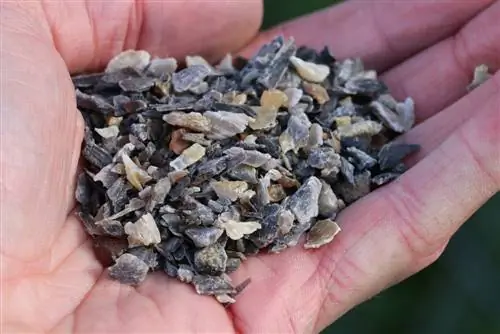
Mineral fertilizers
Mineral fertilizers are also known as artificial fertilizers. These fruit tree fertilizers are designed for a specific composition of nutrients. The main composition of these nutrient suppliers is nitrogen, phosphorus and potassium (NPK). They are available in a directly available, water-soluble form and can therefore be immediately absorbed and utilized by the trees. Mineral fertilizers should always be used carefully. If you use too much or at the wrong time, over-fertilization can quickly occur.
- only a small amount is necessary if soil is regularly fertilized with compost or manure
- Under certain conditions also higher dosage
- for very poor soils
- if a subculture is present
Organo-mineral fruit tree fertilizers
A third option is a combination of organic and mineral fertilizers, which are often commercially available for fertilizing fruit trees. When purchasing, make sure that the fertilizer contains nitrogen and potassium, as fruit trees need the highest amounts of these nutrients. Phosphorus is also necessary, but is only needed in smaller quantities.
Time
A fruit tree is relatively sensitive when it comes to the timing of fertilization. The top priority when fertilizing fruit trees is to only fertilize during the growth phase of the trees. The nutrients are only needed when the trees start to form shoots. In autumn and winter, when the vegetation phase is over and metabolism is reduced to a minimum, it is not necessary to fertilize. During this time, no more nutrients can be absorbed.
- Time for complete fertilizer and organic fertilizers: between February and July
- best at the end of March to the beginning of April
- for apple, cherry and pear trees always before the month of June
- for humus-rich soils: maximum once in spring
- a two-year cycle is often sufficient
- for very sandy, nutrient-poor soils once in spring, once in summer
- Targeted phosphorus and potassium fertilization: in July or early August
Soil analysis
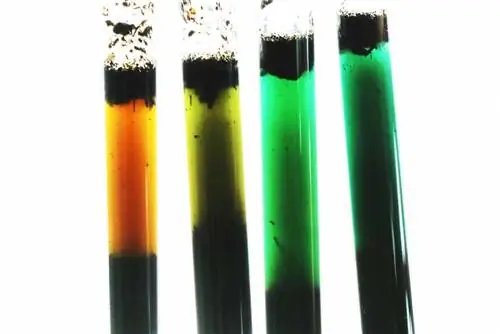
It is recommended to check the nutrient content of the soil approximately every four to five years using a soil analysis. There are ready-to-use sets commercially available in which a soil sample is taken from the tree disc and sent to a laboratory. As a rule, the analysis costs are already included in the purchase price. Not only will you receive the current nutrient levels, but you will also usually receive a fertilizer recommendation so that you can specifically add missing nutrients.
Instructions for fertilizing fruit trees
The best fruit tree fertilizers consist of organic materials plus mineral fertilizers as needed. It is usually easily possible to cover the nutrient requirements of a fruit tree with compost and horn meal. But in some cases compost etc. are not sufficient. Therefore, the addition of artificial fertilizers in small quantities is necessary. The following procedure is recommended for all fruit trees such as cherries, pears or apples that are in a bed or in an open space:
1. Select amount and type of fertilizer
While you hardly have to worry about an overdose when adding compost, this is different with mineral fertilizers. Never exceed the specified amount, but rather fall short of it by a third, as almost every garden soil already contains nutrients. To be sure, you should have a soil sample analyzed.
2. Distribute fertilizer
The roots of fruit trees are formed in a circle around the trunk. The young, absorbent roots, which can absorb nutrients, are located in the outer area below or slightly outside the crown edge, the so-called root plate or root disc. Therefore, it makes little sense to distribute fruit tree fertilizer directly around the trunk. It is best to sprinkle the measured amount of fertilizer evenly onto the garden soil in a thin layer in the area of the root disk.
3. Incorporate fertilizer
Work the fruit tree fertilizer, whether mineral, organic or a combination of both, lightly into the soil using a rake or rake. Since fruit trees form shallow roots that lie close to the surface, the soil under the trees should not be worked too heavily. In dry weather, it makes sense to then slurry the fertilizer with water so that it becomes available to the fruit tree. In addition, the area should, if possible, be covered with a layer of mulch all year round.
Fertilize overgrown tree slices
If plants are growing in the area under the crown, then spreading fertilizer on the ground is not recommended. In this case, the fruit tree fertilizer must be incorporated below the turf or vegetation. To do this, use a digging fork or a spade to poke holes in the ground below the edge of the crown at regular intervals and add the fertilizer there. The fertilizer is then mixed in with water. In general, however, subculture or vegetation below fruit trees is not advantageous.
Fertilizer quantity
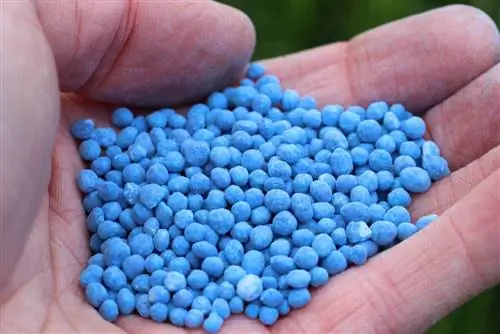
Basically, mineral fertilizer should be used with significantly more caution than organic fertilizer. With organic materials it is hardly possible to over-fertilize. This is completely different with mineral fertilizers. If the easily released substances are not used at the right time or in too large quantities, this can cause the leaves of the fruit tree to change color or change shape. In extreme cases, the mineral fertilizer deprives the tree of water, causing it to “burn”. Although too much nitrogen initially promotes the growth of fruit trees, flowers and fruit often cannot form to the same extent. The tree can also become susceptible to disease and frost damage.
Organic fertilizers
- mature compost: about 3 to 5 liters per tree
- additional 70 to 100 g horn meal for pome fruit as a nitrogen supplier
- for stone fruit 100 to 140 g per tree
Mineral fertilizers
Alternatively, a mineral fertilizer such as blue grain or lime ammonium nitrate can of course also be used to fertilize fruit trees. Although it does not provide additional humus in the garden soil, it can provide the tree with all the important nutrients.
- for older trees: maximum 50 g in two portions
- Never fertilize too much, it is better to use less than 1/3 of the amount
Young trees
How much fertilizer a fruit tree actually needs depends largely on its age. Young trees that have only been planted and used professionally with high-quality soil and compost generally do not need any additional fertilization. The nutrient requirements of older fruit trees, on the other hand, are understandably significantly higher. In most cases, one-time fertilization in spring is recommended. From a trunk height of around one meter, small amounts of fruit tree fertilizer are sufficient in the following years:
- about 1 to 1.5 liters of compost
- additional 10 to 15 g horn meal or horn shavings
- alternatively blue grain or lime ammonium nitrate
- 15 to 20 g per tree in two portions

